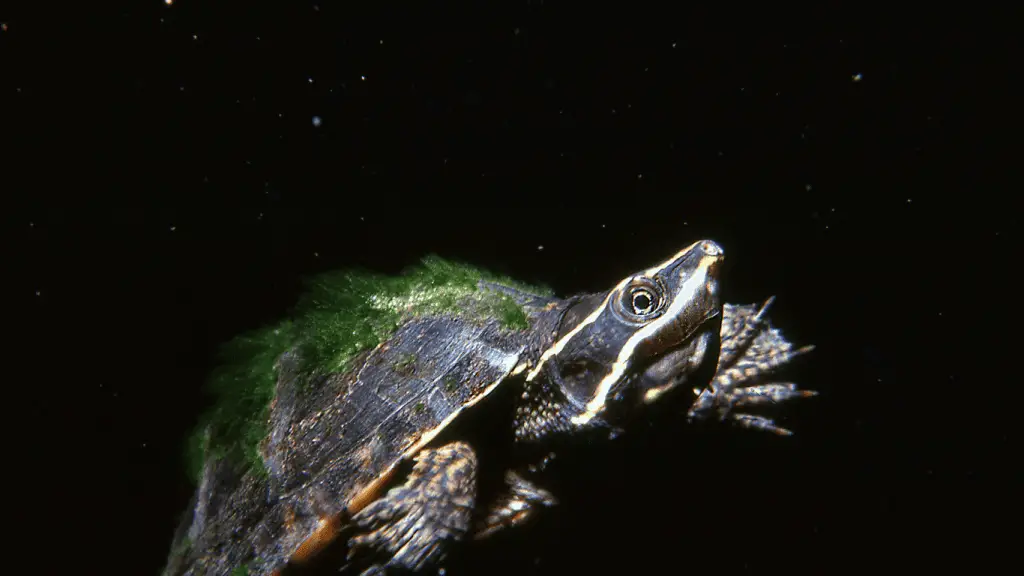The Eastern Musk Turtle is a small, dark turtle with a smooth, domed upper shell and reduced lower shell. It is also known as the “stinkpot” due to the musky odor it emits when threatened or handled. These turtles are native to the eastern United States and are commonly kept as pets due to their easy care requirements.
In this comprehensive guide, we will cover all aspects of Eastern Musk Turtle care, from their diet to their habitat. We will also discuss their behavior, breeding habits, and common health issues.
Understanding Eastern Musk Turtle

The Eastern Musk Turtle, scientifically known as Sternotherus odoratus, is a species of reptile belonging to the Kinosternidae family. They are also commonly referred to as the Stinkpot due to their ability to release a foul-smelling musk when they feel threatened.
The Eastern Musk Turtle is native to the eastern United States and Canada and is primarily found in slow-moving bodies of water like swamps or rivers that have muddy bottoms.
This species of turtle has a highly domed shell that is dark gray-brown to black in color. Their carapace can grow up to 5.5 inches in length and is smooth to the touch. The Eastern Musk Turtle has a long neck and rather short legs, making it well-suited for its aquatic lifestyle.
The Eastern Musk Turtle is an omnivore and will eat a variety of foods, including fruits, vegetables, insects, and meat. A well-balanced diet for a pet Eastern Musk Turtle should be mainly based on pellets, with the occasional fruits, vegetables, and dried insects. It is important to note that feeding them too much protein can lead to health problems, so it is essential to monitor their diet carefully.
In terms of taxonomy, the Eastern Musk Turtle belongs to the genus Sternotherus, which is a group of small turtles that are native to North America. They are part of the larger Testudines order, which includes all turtles and tortoises. The Kinosternidae family is also known as the Mud and Musk Turtle family and includes other species like the Common Musk Turtle (Kinosternon subrubrum).
Physical Characteristics
Size and Weight
The Eastern Musk Turtle is a small species of turtle, with males being slightly larger than females. Adult males typically measure between 3.5 to 4.5 inches in carapace length, while females measure between 4 to 5 inches. The weight of an adult Eastern Musk Turtle ranges from 2 to 5 ounces.
Carapace and Plastron
The Eastern Musk Turtle has a flattened dark brown or black shell with yellow markings on it. The carapace of this species is smooth and dome-shaped, while the plastron is reduced and has only one movable hinge located anteriorly. The pectoral scute is square-shaped and contacts broadly at the midline.
Distinctive Markings
The Eastern Musk Turtle has distinctive markings that make it easy to identify. They have an orange stripe along each side of their head and neck that extends down to their tails. In addition, they have small barbels on their chins and a small, pointed tail. The claws of the Eastern Musk Turtle are sharp and well-developed.
The Eastern Musk Turtle is an interesting species with unique physical characteristics. They are small in size and have flattened, black shells with yellow markings. The orange stripes on their head and neck, along with their small barbels and pointed tail, make them easy to identify. Their sharp claws are also well-developed and allow them to climb and move around easily.
Habitat and Distribution
Natural Habitat
The Eastern Musk Turtle is a small aquatic turtle that is found in the eastern United States and Canada. They prefer slow-moving bodies of water like swamps, ponds, lakes, and rivers that have muddy bottoms where they use their snout to dig for food. They are also known to inhabit areas with dense vegetation, such as marshes and wetlands. The Eastern Musk Turtle is a semi-aquatic species, spending most of its time in the water but coming to land to bask in the sun or lay eggs.
Geographical Range
The Eastern Musk Turtle has a wide distribution across North America. It can be found from Ontario, Canada, down to the Gulf of Mexico in the United States. In the United States, it is most commonly found in the eastern half of the country, from the Great Lakes region down to the Gulf Coast.
In Missouri, it is found throughout the state, with the exception of the Ozarks region. The Eastern Musk Turtle is a common species and is not considered to be threatened or endangered.
Here is a table summarizing the Eastern Musk Turtle’s geographical range:
| Country | Region |
|---|---|
| Canada | Ontario |
| United States | The eastern half of the country, from the Great Lakes region down to the Gulf Coast |
| Missouri | Throughout the state, with the exception of the Ozarks region |
In summary, the Eastern Musk Turtle is a small aquatic turtle that can be found in a variety of habitats, including swamps, ponds, lakes, and rivers. It has a wide distribution across North America, from Ontario down to the Gulf of Mexico in the United States. In Missouri, it is found throughout the state, with the exception of the Ozarks region.
Behavior and Temperament
In the Wild
Eastern Musk Turtles are generally shy and tend to hide from predators in the wild. They are primarily aquatic turtles and can be found in slow-moving streams, lakes, and ponds. These turtles are excellent swimmers and can hold their breath for a long time. They are also very good climbers and can easily climb out of the water to bask in the sun.
In the wild, Eastern Musk Turtles feed on a variety of aquatic animals, including insects, snails, crayfish, and small fish. They are known to be opportunistic feeders and will eat almost anything they can catch.
In Captivity
Eastern Musk Turtles are popular pets due to their small size and easy-to-care-for nature. They are generally docile and can be handled with care. However, they can become stressed if they are handled too much or too roughly.
In captivity, Eastern Musk Turtles require a large tank with a basking area, a water heater, and a water filter. They also need a UVB light to help them synthesize vitamin D3. These turtles are primarily aquatic and need a lot of swimming space. They also need a basking area where they can dry off and regulate their body temperature.
Handling Eastern Musk Turtles requires care and patience. They can be easily stressed if they are handled too much or too roughly. It is important to support their body properly when picking them up and to avoid picking them up by their tails. If they are handled gently and with care, they can become quite tame and will even come to recognize their owners.
Diet and Feeding
Eastern Musk Turtles are omnivorous, meaning they eat both plant and animal matter. In the wild, their diet consists of a variety of prey, including insects, worms, mollusks, and fish. As pets, it is important to provide a well-balanced diet that mimics their natural diet.
Wild Diet
In the wild, Eastern Musk Turtles feed on a variety of prey. They consume insects such as beetles and crickets, as well as other foods, including worms, mollusks (such as snails), crustaceans (like shrimp), and fish. Their diet varies depending on the availability of food in their habitat.
Captive Diet
In captivity, Eastern Musk Turtles should be fed a balanced diet consisting of pellets, vegetables, and occasional fruits. A well-balanced diet for a pet musk turtle will be mainly based on pellets, with the occasional fruits, vegetables, and dried insects. It is important to avoid overfeeding and to provide a varied diet to ensure they get all the necessary nutrients.
Pellets should make up the majority of their diet, and they should be of high quality. It is best to choose pellets specifically formulated for musk turtles, as they contain the necessary nutrients for their health. Vegetables such as kale, spinach, and celery should also be included in their diet.
It is important to note that calcium and phosphorus play a significant role in building solid skeletons and shells. If the diet lacks calcium, it will cause soft shells or deformed bones. Therefore, vets suggest feeding the musk turtles vitamin and mineral supplements. Vitamin D3 is necessary for calcium absorption.
Eastern Musk Turtle as Pets
If you’re considering getting an Eastern Musk Turtle as a pet, there are a few things you need to know to ensure their health and happiness. In this section, we’ll cover the essential information about tank setup, temperature, lighting, feeding, and handling.
Tank Setup
When it comes to tank setup, the most important thing to consider is the size of the tank. Eastern Musk Turtles require a minimum of a 20-gallon tank for one turtle, with an additional 10 gallons of water per turtle. The tank should have a basking area and a filter to keep the water clean.
The substrate should be sand or small gravel, and the water temperature should be maintained between 75-80°F. The enclosure should also have a humidity level of 50-60% to ensure proper shedding.
Temperature and Lighting
Temperature and lighting are crucial for the health of your Eastern Musk Turtle. The basking area should have a temperature between 85-90°F, and the rest of the tank should be between 75-80°F. You can use a heat lamp to maintain the temperature and a UVB light to provide the necessary lighting for your turtle.
Feeding Your Pet
Eastern Musk Turtles are omnivores, and their diet should consist of both animal and plant matter. You can feed them commercial turtle food, as well as live or frozen food such as bloodworms, earthworms, and small fish. You can also give them small amounts of fruits and vegetables, such as kale, lettuce, and strawberries.
Handling Your Pet
Eastern Musk Turtles are not the most social of turtles and may not enjoy being handled. However, you can still interact with your pet by placing your hand in the tank and allowing them to swim around you. If you need to handle your turtle, make sure to support its body and avoid picking them up by its shell.
Reproduction and Lifespan
Breeding
Eastern Musk Turtles reach sexual maturity between 3-5 years old. During the breeding season, males will become more active and aggressive toward each other to establish dominance. They will also begin to court females by swimming around them and nipping at their legs and tails. Once a female is receptive, the male will mount her and copulate. Females can lay up to 5 clutches of eggs per year, with each clutch containing 2-5 eggs.
Hatchlings
The eggs of Eastern Musk Turtles have a relatively short incubation period of around 60 days. Once the eggs hatch, the hatchlings will emerge from the nest and make their way to the water. Hatchlings are vulnerable to predators and should be housed in a safe environment until they are large enough to be released into the wild.
Lifespan
Eastern Musk Turtles have a relatively long lifespan, with an average lifespan of around 60 years. However, they have been known to live up to 100 years in captivity. Proper care and a healthy diet can help ensure a longer lifespan for your pet turtle.
It is important to note that Eastern Musk Turtles are protected in some states and may require permits for breeding or keeping them as pets. Additionally, it is illegal to collect eggs or disturb nests of wild Eastern Musk Turtles. If you are interested in breeding or keeping Eastern Musk Turtles, it is important to research and comply with all relevant laws and regulations.
Health and Diseases
Keeping your Eastern Musk Turtle healthy is important to ensure a long and happy life for your pet. While they are generally hardy creatures, they can still fall ill or develop health issues if not properly cared for. Here are some common health concerns to watch out for:
Common Diseases
Eastern Musk Turtles can be susceptible to a variety of diseases, some of which can be serious. Here are some of the most common diseases that can affect these turtles:
- Respiratory Infections: These can be caused by a variety of bacteria and viruses and can lead to symptoms like wheezing, coughing, and nasal discharge.
- Shell Rot: This is a fungal infection that can occur if the turtle’s shell is damaged or not kept clean and dry.
- Eye Infections: These can be caused by bacteria or viruses and can lead to symptoms like redness, swelling, and discharge.
If you notice any of these symptoms, it’s important to take your turtle to a veterinarian who specializes in reptiles as soon as possible.
Weight Loss and Lethargy
If your Eastern Musk Turtle is losing weight or seems lethargic, there could be a few possible causes:
- Poor Diet: Make sure you are feeding your turtle a balanced diet that includes both protein and vegetables.
- Hibernation: Eastern Musk Turtles may hibernate during the winter months, so if your turtle is not eating or moving much during this time, it could be normal behavior.
- Illness: Weight loss and lethargy can also be symptoms of an underlying illness, so it’s important to have your turtle checked by a vet if you notice these symptoms.
Parasites
Parasites are another common health concern for Eastern Musk Turtles. Here are some of the most common parasites that can affect these turtles:
- Internal Parasites: These can include worms and protozoa and can lead to symptoms like diarrhea, weight loss, and lethargy.
- External Parasites: These can include mites and ticks and can lead to symptoms like itching and skin irritation.
To prevent parasites, make sure you are keeping your turtle’s enclosure clean and dry. If you suspect your turtle has parasites, take them to a veterinarian who specializes in reptiles for treatment.
Conservation Status
The Eastern Musk Turtle is assessed as a species of Special Concern by the Committee on the Status of Endangered Wildlife in Canada. This species is also considered secure in the United States. Eastern Musk Turtles are widespread and common throughout their range, but they face several threats that could impact their populations.
Wetland habitat loss, shoreline development, pollution, and recreational activities such as motorboat collisions and fishing traps are the primary threats to Eastern Musk Turtles. These threats have the potential to reduce the quality and quantity of habitat available to these turtles, leading to declines in populations.
However, Eastern Musk Turtles have a relatively high reproductive potential, which may help them recover from population declines. They reach sexual maturity at a young age and can produce multiple clutches of eggs each year. Additionally, Eastern Musk Turtles can adapt to different habitats, which may allow them to persist in areas that have been altered by human activities.
Conservation efforts for Eastern Musk Turtles include habitat protection, restoration, and management. Protecting and restoring wetlands can provide essential habitat for these turtles and other wetland-dependent species. Additionally, reducing the impact of recreational activities on turtles and their habitats can help to minimize negative effects on populations.
Interesting Facts
The Eastern Musk Turtle, also known as the Common Musk Turtle or Stinkpot Turtle, is a fascinating creature with many interesting facts. Here are a few:
- Stinkpot Turtle: As the name suggests, the Eastern Musk Turtle has a unique defense mechanism. It can release a foul musky odor from scent glands on the edge of its shell. This smell is used to deter predators and can linger for hours. While not harmful to humans, it is certainly unpleasant.
- Small Size: The Eastern Musk Turtle is one of the smallest turtle species in the world. Adults typically range in size from 2 to 4.5 inches, with some occasionally growing up to 6 inches in length. This makes them a popular choice for pet owners, as they require less space than larger turtles.
Algae Eaters: Eastern Musk Turtles are known for their love of algae. They spend much of their time in shallow, slow-moving water, where they feed on a variety of aquatic plants and animals. They are particularly fond of algae, which they scrape off rocks and other surfaces with their sharp beaks.
Named by Sonnini and Latreille: The Eastern Musk Turtle was first described by French naturalists Pierre Sonnini and Pierre André Latreille in 1801. They named the species Sternotherus odoratus, which means “fragrant sternum” in Latin, a reference to the musky odor the turtles can produce.
- Smith’s Musk Turtle: The Eastern Musk Turtle is closely related to Smith’s Musk Turtle, which is found in the southwestern United States. While they look similar, Smith’s Musk Turtles are slightly larger and have a more pointed snout. They also have a different coloration, with more prominent yellow markings on their heads and legs.
FAQ
What is the average lifespan of an Eastern Musk Turtle?
The average lifespan of an Eastern Musk Turtle is around 20 years. However, with proper care, they can live up to 30 years in captivity.
How large do Eastern Musk Turtles typically grow?
Eastern Musk Turtles are small turtles, typically growing to be between 3.5 and 5 inches in length. Males are usually smaller than females.
What are the recommended tank requirements for an Eastern Musk Turtle?
Eastern Musk Turtles require a tank that is at least 20 gallons in size. The tank should have a basking area, a UVB light, and a water heater to maintain a temperature range of 75-80°F. The water should be deep enough to allow the turtle to swim and should be changed regularly to maintain water quality.
Where can I find Eastern Musk Turtles for sale?
Eastern Musk Turtles can be found for sale at pet stores, reptile expos, and online from reputable breeders. It is important to ensure that the seller is reputable and that the turtle is healthy before purchasing.
What is the ideal temperature range for an Eastern Musk Turtle’s habitat?
The ideal temperature range for an Eastern Musk Turtle’s habitat is between 75-80°F. The basking area should be warmer, around 85°F. It is important to provide a temperature gradient in the tank so that the turtle can regulate its body temperature.
Are Eastern Musk Turtles a good choice for beginner pet owners?
Eastern Musk Turtles can be a good choice for beginner pet owners, as they are relatively easy to care for and do not require a lot of space. However, it is important to do research and ensure that you can provide the necessary care before getting a pet turtle.




Leave a Reply